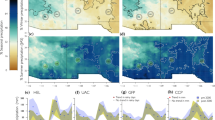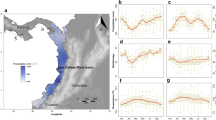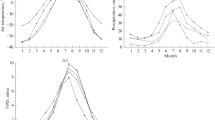Abstract
Tree-ring width of Larix gmelinii (Rupr.) Rupr., ratios of stable isotopes of C (δ13C) and O (δ18O) of whole wood and cellulose chronologies were obtained for the northern part of central Siberia (Tura, Russia) for the period 1864–2006. A strong decrease in the isotope ratios of O and C (after atmospheric δ13C corrections) and tree-ring width was observed for the period 1967–2005, while weather station data show a decrease in July precipitation, along with increasing July air temperature and vapor pressure deficit (VPD). Temperature at the end of May and the whole month of June mainly determines tree radial growth and marks the beginning of the vegetation period in this region. A positive correlation between tree-ring width and July precipitation was found for the calibration period 1929–2005. Positive significant correlations between C isotope chronologies and temperatures of June and July were found for whole wood and cellulose and negative relationships with July precipitation. These relationships are strengthened when the likely physiological response of trees to increased CO2 is taken into account (by applying a recently developed δ13C correction). For the O isotope ratios, positive relationships with annual temperature, VPD of July and a negative correlation with annual precipitation were observed. The δ18O in tree rings may reflect annual rather than summer temperatures, due to the late melting of the winter snow and its contribution to the tree water supply in summer. We observed a clear change in the isotope and climate trends after the 1960s, resulting in a drastic change in the relationship between C and O isotope ratios from a negative to a positive correlation. According to isotope fractionation models, this indicates reduced stomatal conductance at a relatively constant photosynthetic rate, as a response of trees to water deficit for the last half century in this permafrost region.





Similar content being viewed by others
References
Abaimov AP, Bondarev AI, Zyryanova OA, Shitova SA (1997) Polar forests of Krasnoyarsk region. Novosibirsk, Nauka, p 208
Alvarez UP, Körner C (2007) Low temperature limits of root growth in deciduous and evergreen temperature tree species. Funct Ecol 21:211–218
Arbatskaya MK (1998) Long term variability of climate, tree growth and fire frequencies in taiga of Middle Siberia (in Russian). PhD thesis, Institute of Forest, Krasnoyarsk, Russia
Arneth A, Lloyd J, Santruckova H, Bird M, Grigoryev S, Kalaschnikov YN, Gleixner G, Schulze ED (2002) Response of central Siberian Scots pine to soil water deficit and long-term trends in atmospheric CO2 concentration. Global Biogeochem Cycles 16. 1.10.1029/2000GB001374
Barber VA, Juday GP, Finney B (2000) Reduced growth of Alaskan white spruce in the twentieth century from temperature-induced drought stress. Nature 405:668–673
Barber VA, Juday GP, Finney BP, Wilmking M (2004) Reconstruction of summer temperature in interior Alaska from tree ring proxies: evidence for changing synoptic climate regimes. Clim Change 63:91–120
Barbour MM, Andrei TJ, Farquhar GD (2001) Correlation between oxygen isotope ratios of wood constituents of Quercus and Pinus samples from around the world. Aust J Plant Physiol 28:335–348
Borella S, Leuenberger M, Saurer M (1998) Reducing uncertainties in δ13C analysis of tree rings: pooling, milling, and cellulose extraction. J Geophys Res 103, NO.D.16:19519–19526
Briffa KR (2000) Annual climate variability in the Holocene: interpreting the message of ancient trees. Quat Sci Rev 19:87–105
Briffa K, Schweingruber F, Jones P, Osborn T (1998) Reduced sensitivity of recent tree growth to temperature at high northern latitudes. Nature 391:678–682
Cernusak LA, Pate JS, Farquhar GD (2003) Diurnal variation in the stable isotope composition of water and dry matter in fruiting Lupinus angustifolius under field conditions. Plant Cell Environ 25:893–907
Cook ER, Kairiukstis LA (eds) (1990) Methods of dendrochronology. Applications in the environmental sciences. Kluwer, Dordrecht, p 394
Cook ER, Krusic PJ (2008) A tree-ring standardization program based on detrending and autoregressive time series modeling, with interactive graphics (ARSTAN)
Craig H (1961) Isotopic variations in meteoric waters. Science 133:1702–1703
D’Arrigo R, Kaufmann RK, Davi N, Jacoby GC, Laskowski C, Myneni RB, Cherubini P (2004) Thresholds for warming induced growth decline at elevational tree line in the Yukon territory, Canada. Glob Biogeochem Cycles 18. doi:10.1029/2004GB002249
Dansgaard W (1964) Stable isotopes in precipitation. Tellus B Chem Phys Meteorol 16:436–468
Delisle G (2007) Near-surface permafrost degradation: how severe during the 21st century? Geophys Res Lett 34:L09503. doi:1029/2007GL029323
Drake BG, GonzalezMeler MA, Long SP (1997) More efficient plants: a consequence of rising atmospheric CO2? Annu Rev Plant Physiol Plant Mol Biol 48:609–639
Duquensnay A, Breda N, Stievenard M, Dupouey JL (1998) Changes of tree-ring δ13C and water-use efficiency of beech (Fagus sylvatica L.) in north-eastern France during the past century. Plant Cell Environ 21:565–572
Farquhar GD, Lloyd J (1993) Carbon and oxygen isotope effects in the exchange of carbon dioxide between plants and the atmosphere. In: Ehleringer JR, Hall AE, Farquhar GD (eds) Stable isotope and plant carbon/water relations. Academic Press, San Diego, pp 47–70
Farquhar GD, Ehleringer JR, Hubick KT (1989) Carbon isotope discrimination and photosynthesis. Annu Rev Plant Physiol Plant Mol Biol 40:503–537
Francey RJ, Allison CE, Etheridge DM (1999) A 1000-year high precision record of δ13C in atmospheric CO2. Tellus B Chem Phys Meteorol 51:170–193
Gagen MH, McCarroll D, Edouard J-L (2004) Latewood width, maximum density and stable carbon isotope ratios of pine as climate indicators in a dry, subalpine environment. Arct Antarct Alp Res 36:166–171
Gagen MH, McCarroll D, Edouard J-L (2006) Combining ring width, density and stable carbon isotope proxies to enhance the climate signal in tree-rings: an example from the southern French Alps. Clim Change 78:363–379
Gagen MH, McCarrol D, Loader NJ, Robertson I, Jalkanen R, Anchukaitis KJ (2007) Exorcising the ‘segment length curse’ summer temperature reconstruction since AD 1640 using non de-trend stable carbon isotope ratios from line trees in northern Finland. Holocene 17:433–444
Gagen MH, McCarrol D, Robertson I, Loader NJ, Jalkanen R (2008) Do tree ring δ13C series from Pinus sylvestris in northern Fennoscandia contain long-term non-climatic trends? Chem Geol 252:42–51
Graumlich LJ (1991) Subalpine tree growth, climate, and increasing CO2: an assessment of recent growth trends. Ecology 72:1–11
Helle G, Schleser GH (2004) Beyond CO2-fixation by Rubisco–an interpretation of 13C/12C variations in tree rings from novel intra-seasonal studies on broad-leaf trees. Plant Cell Environ 27:367–380
IPCC (2001) Climate change 2001: the scientific basis. In: Houghton JT, et al. (eds) Contribution of Working Group I to the 3rd assessment report of the Intergovernmental Panel on Climate Change. Cambridge University Press, USA
IPCC (2007) 4th assessment report, chapter 6. Intergovernmental Panel on Climate Change, pp 434–497
Kagawa A, Naito D, Sugimoto A, Maximov TC (2003) Effects of spatial variability in soil moisture on widths and δ13C values of eastern Siberian tree rings. J Geophys Res 108:D164500. doi:10.1029/2002JD003019
Kajimoto T, Matsuura Y, Osawa A, Prokushkin AS, Sofronov MA, Abaimov AP (2003) Root system development of Larix gmelinii trees affected by micro-scale conditions of permafrost soils in central Siberia. Plant Soil 255:281–292
Keeling CD, Chin JFS, Whorf TP (1996) Increased activity of northern vegetation inferred from atmospheric CO2 measurements. Nature 382:146–149
Kharuk VI, Ranson KJ, Dvinskaya ML (2008) Wildfires dynamic in the larch dominance zone. Geophys Res Lett 35:L01402. doi:10.1029/2007GL032291
Kirdyanov AV, Hughes M, Vaganov EA, Schweingruber F, Silkin P (2003) The importance of early summer temperature and date of snow melt for tree growth in the Siberian Subarctic. Trees 17:61–69
Kirdyanov AV, Treydte KS, Nikolaev A, Helle G, Schleser GH (2008) Climatic signals in tree ring width, density and δ13C from larches in Eastern Siberia (Russia). Chem Geol 252:31–41
Knorre AA, Kirdyanov AA, Vaganov EA (2006) Climatically induced interannual variability in aboveground production in forest-tundra and northern taiga of central Siberia. Oecologia 147:86–95. doi:10.1007/s00442-005-0248-4
Körner C (2000) Biosphere responses to CO2 enrichment. Ecol Appl 10(6):1590–1619
Kramer PJ, Boyer JS (1995) Water relations of plants and soils. Academic Press, New York, pp 167–199
Leavitt SW, Long A (1991) Seasonal stable-carbon isotope variability in tree rings: possible paleoenvironmental signals. Chem Geol (Isot Geosci Sect) 87:59–70
Leavitt SW, Chase TN, Rajagopalan B, Lee E, Lawrence PJ (2008) Southwestern US tree-ring carbon isotope indices as a possible proxy for reconstruction of greenness of vegetation. Geophys Res Lett 35:L12704. doi:10.1029/2008GL033894
Loader NJ, Robertson I, Barker AC, Switsur VR, Waterhouse JS (1997) Improved technique for the batch processing of small whole wood samples to alpha-cellulose. Chem Geol 136:313–317
Loader NJ, Robertson I, McCarroll D (2003) Comparison of stable carbon isotope ratios in the whole wood, cellulose and lignin of oak tree rings, Palaeogeography, Palaeoclimatology. Palaeoecology 196:395–407
McCarroll D, Loader NJ (2004) Stable isotopes in tree rings. Quat Sci Rev 23:771–801
McCarroll D, Pawellek F (2001) Stable carbon isotope ratios of Pinus sylvestris from northern Finland and the potential for extracting a climate signal from long Fennoscandian chronologies. Holocene 11:517–526
McCarroll D, Gagen MH, Loader NJ, Robertson I, Anchukaitis KJ, Los S, Young G, Jalkanen R, Kirchhefer A, Waterhouse JS (2009) Correction of tree ring stable carbon isotope chronologies for changes in the carbon dioxide content of the atmosphere. Geochim Cosmochim Acta. doi:10.1016/j.ca.2008.11.041
Murray FW (1967) On the computation of saturation vapor pressure. J Appl Meteorol 6:203–204
Myneni RB, Keeling CD, Tucker CJ, Asrar G, Namani RR (1997) Increased plant growth in the northern high latitudes from 1981–1991. Nature 386:698–702
Osterkamp TE, Romanovsky VE (1999) Evidence for warming and thawing of discontinuous permafrost in Alaska. Permafr Periglac Process 10(1):17–37
Prokushkin AS, Knorre AA, Kirdyanov AV, Schulze ED (2006) Productivity of mosses and organic matter accumulation in the litter of sphagnum larch forest in the permafrost zone. Russ J Ecol 374:225–232. doi:10.1134/S1067413606040023
Rinn F (1996) TSAP, V. 3.6. Reference manual computer program for tree ring analysis and presentation. Heidelberg, p 263
Roden JS, Ehleringer JR (2000) Hydrogen and oxygen isotope ratios of leaf water and tree ring cellulose for field grown riparian trees. Oecologia 123:481–489
Saurer M, Siegwolf RTW (2007) Human impacts on tree ring growth reconstructed from stable isotopes. In: Dawson Todd E, Siegwolf RTW (eds) Stable isotopes as indicators of ecological change terrestrial ecology series. Elsevier, Amsterdam, pp 49–62
Saurer M, Borella S, Schweingruber F, Siegwolf R (1997a) Stable isotopes in tree rings of beech: climatic versus site-related influences. Trees 11:291–297
Saurer M, Aellen K, Siegwolf R (1997b) Correlating δ13C and δ18O in cellulose of trees. Plant Cell Environ 20:1543–1550
Saurer M, Robertson I, Siegwolf R, Leuenberger M (1998) Oxygen isotope analysis of cellulose: an inter-laboratory comparison. Anal Chem 70(10):2074–2080
Saurer M, Schweingruber F, Vaganov EA, Schiyatov SG, Siegwolf R (2002) Spatial and temporal oxygen isotope trends at the northern tree-line in Eurasia. Geophys Res Lett 29(9): 10.1029/2001GL013739
Scheidegger Y, Saurer M, Bahn M, Siegwolf R (2000) Linking stable isotopes with stomatal conductance and photosynthetic capacity: a conceptual model. Oecologia 125:350–357
Schweingruber FH (1996) Tree rings and environment dendroecology. Paul Haupt Publ Bern, Stuttgart, p 609
Serreze MC, Dyurgerov M, Romanovsky V, Oechel WC, Zhang JT, Barry RG, Walsh JE, Chappin III, Osterkamp T (2000) Observational evidence of recent change in the northern high–latitude environment. Clim Change 46(1–2):159–207
Sidorova OV, Siegwolf RTW, Saurer M, Naurzbaev M, Vaganov EA (2008) Isotopic composition (δ13C, δ18O) in wood and cellulose of Siberian larch trees for early Medieval and recent periods. J Geophys Res Biogeosci 113:G02019. doi:10.1029/2007JG000473
Sternberg L, Deniro MJ, Savidge R (1986) Oxygen isotope exchange between metabolites and water during biochemical reactions leading to cellulose synthesis. Plant Physiol 82:423-427
Sugimoto A, Yanagisawa N, Naito D, Fujita N, Maximov TC (2002) Importance of permafrost as a source of water for plants in east Siberian taiga. Ecol Res 17:493–503
Treydte K, Schleser GH, Schweingruber FH, Winiger M (2001) The climatic significance of δ13C in subalpine spruce (Loetschental, Swiss Alps). Tellus B Chem Phys Meteorol 53B:593–611
USDA (1998) Keys to soil taxonomy, 8th edn. USDA, Natural Resources Conservation Service, Washington DC
Vaganov EA, Shiyatov SG (1998) Dendrochronological study in Siberian climate. In: The problem of climate reconstruction and nature in the Holocene and Pleistocene. Novosibirsk, pp 56–63
Vaganov EA, Hughes MK, Kirdyanov AV, Schweingruber FH, Silkin PP (1999) Influence of snowfall and melt timing on tree growth in subarctic Eurasia. Nature 400:149-151
Wigley T, Briffa K, Jones P (1984) On the average value of correlated time series, with application in dendroclimatology and hydrometeorology. J Clim Appl Meteorol 23:201–213
Wilmking M, Juday GP (2005) Longitudinal variation of radial growth at Alaska’s northern treeline-recent changes and possible scenarios for the 21st century. Glob Planet Change 47:282–300
Yakir DL, Sternberg L (2000) The use of stable isotopes to study ecosystem gas exchange. Oecologia 123:297–311
Acknowledgments
This study was supported by the Swiss National Science Foundation (SNF 200021_121838/1, PIOI2-119259), the Joint Research Project SCOPES (no. IB73A0-111134), and the Russian Foundation for Basic Research (RFBR nos. 06-05-64095-a, 07-04-96819 r_enisey, 07-04-00293a, 09-05-98015_r_sibir_a). This work was conducted in collaboration with the European Union-funded Millennium Project (017008). Special thanks to Prof. Danny McCarroll from Swansea University, UK for useful discussion and valuable comments on the early stage of this manuscript. We would like to thank the editor-in-chief, Christian Körner, the handling editor, Dan Yakir, and the two anonymous reviewers for their helpful comments.
Author information
Authors and Affiliations
Corresponding author
Additional information
Communicated by Dan Yakir.
Rights and permissions
About this article
Cite this article
Sidorova, O.V., Siegwolf, R.T.W., Saurer, M. et al. Do centennial tree-ring and stable isotope trends of Larix gmelinii (Rupr.) Rupr. indicate increasing water shortage in the Siberian north?. Oecologia 161, 825–835 (2009). https://doi.org/10.1007/s00442-009-1411-0
Received:
Accepted:
Published:
Issue Date:
DOI: https://doi.org/10.1007/s00442-009-1411-0




